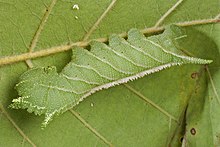Caterpillar larva
Caterpillar larva
Butterfly larvae, or caterpillars, consume plant leaves and spend practically all of their time searching for and eating food. Although most caterpillars are herbivorous, a few species are predators: Spalgis epius eats scale insects,[45] while lycaenids such as Liphyra brassolis are myrmecophilous, eating ant larvae.[46]
Some larvae, especially those of the Lycaenidae, form mutual associations with ants. They communicate with the ants using vibrations that are transmitted through the substrate as well as using chemical signals.[47][48] The ants provide some degree of protection to these larvae and they in turn gather honeydew secretions. Large blue (Phengaris arion) caterpillars trick Myrmica ants into taking them back to the ant colony where they feed on the ant eggs and larvae in a parasitic relationship.[49]
Caterpillars mature through a series of developmental stages known as instars. Near the end of each stage, the larva undergoes a process called apolysis, mediated by the release of a series of neurohormones. During this phase, the cuticle, a tough outer layer made of a mixture of chitin and specialized proteins, is released from the softer epidermis beneath, and the epidermis begins to form a new cuticle. At the end of each instar, the larva moults, the old cuticle splits and the new cuticle expands, rapidly hardening and developing pigment.[50] Development of butterfly wing patterns begins by the last larval instar.
Caterpillars have short antennae and several simple eyes. The mouthparts are adapted for chewing with powerful mandibles and a pair of maxillae, each with a segmented palp. Adjoining these is the labium-hypopharynx which houses a tubular spinneret which is able to extrude silk.[13] Caterpillars such as those in the genus Calpodes (family Hesperiidae) have a specialized tracheal system on the 8th segment that function as a primitive lung.[51] Butterfly caterpillars have three pairs of true legs on the thoracic segments and up to six pairs of prolegs arising from the abdominal segments. These prolegs have rings of tiny hooks called crochets that are engaged hydrostatically and help the caterpillar grip the substrate.[52] The epidermis bears tufts of setae, the position and number of which help in identifying the species. There is also decoration in the form of hairs, wart-like protuberances, horn-like protuberances and spines. Internally, most of the body cavity is taken up by the gut, but there may also be large silk glands, and special glands which secrete distasteful or toxic substances. The developing wings are present in later stage instars and the gonads start development in the egg stage.[13]



Comments
Post a Comment